| HOME |
|---|
LYRA
The Harp
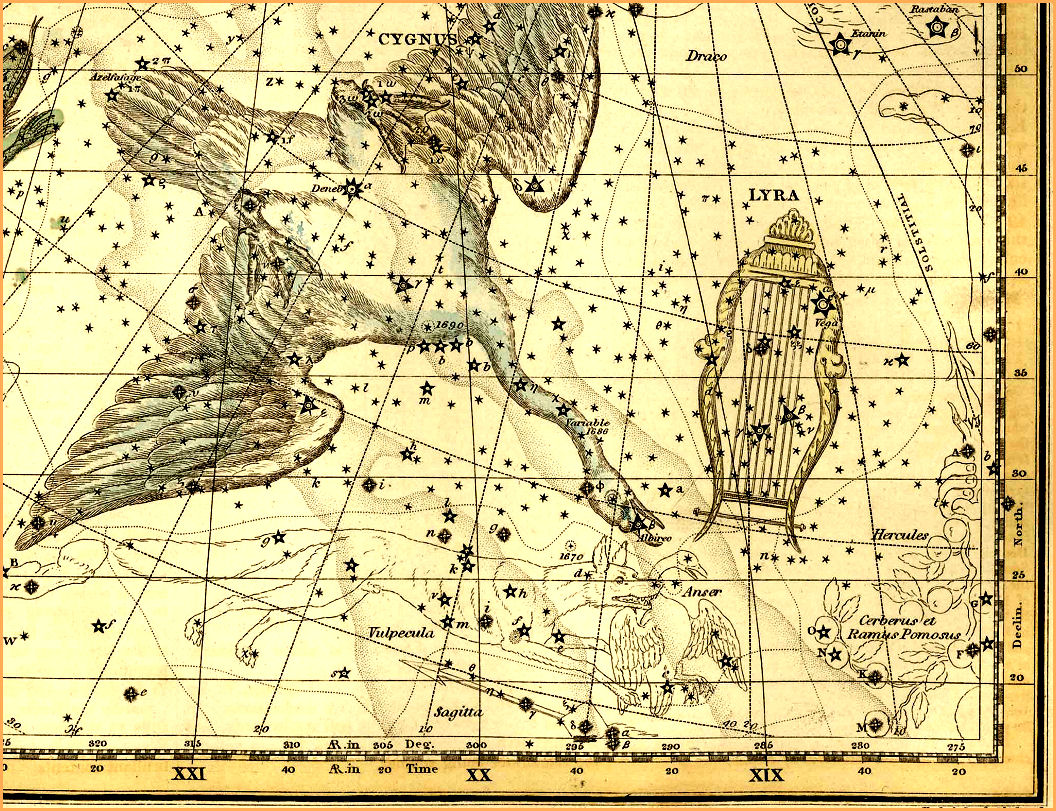
Lyra - Celestial Atlas by Alexander Jamieson - 1822
| HOME |
|---|

It is said the god Hermes (Mercury) took the shell of a tortoise, poked holes in the rim, stretched strips of cow gut between them, and the lyre, the first ancient form of the harp, was born. That first instrument ended up with the god Apollo, who perfected its use and became the god of music. And Apollo taught everything he knew to Orpheus, who became the most skilled and famous player of the lyre in the ancient world. His music contained a powerful magic that charmed everyone that heard it. It even charmed the rocks and the trees. Traveling with Jason and the Argonauts in search of the Golden Fleece, his music was powerful enough to save them all from the song of the Sirens. When Orpheus died, the Muses asked Zeus ( Jupiter) to place the lyre in the sky, to honour the god-like music it produced. It was carried up to the heavens by the wings of a vulture, as is depicted in some older star charts.
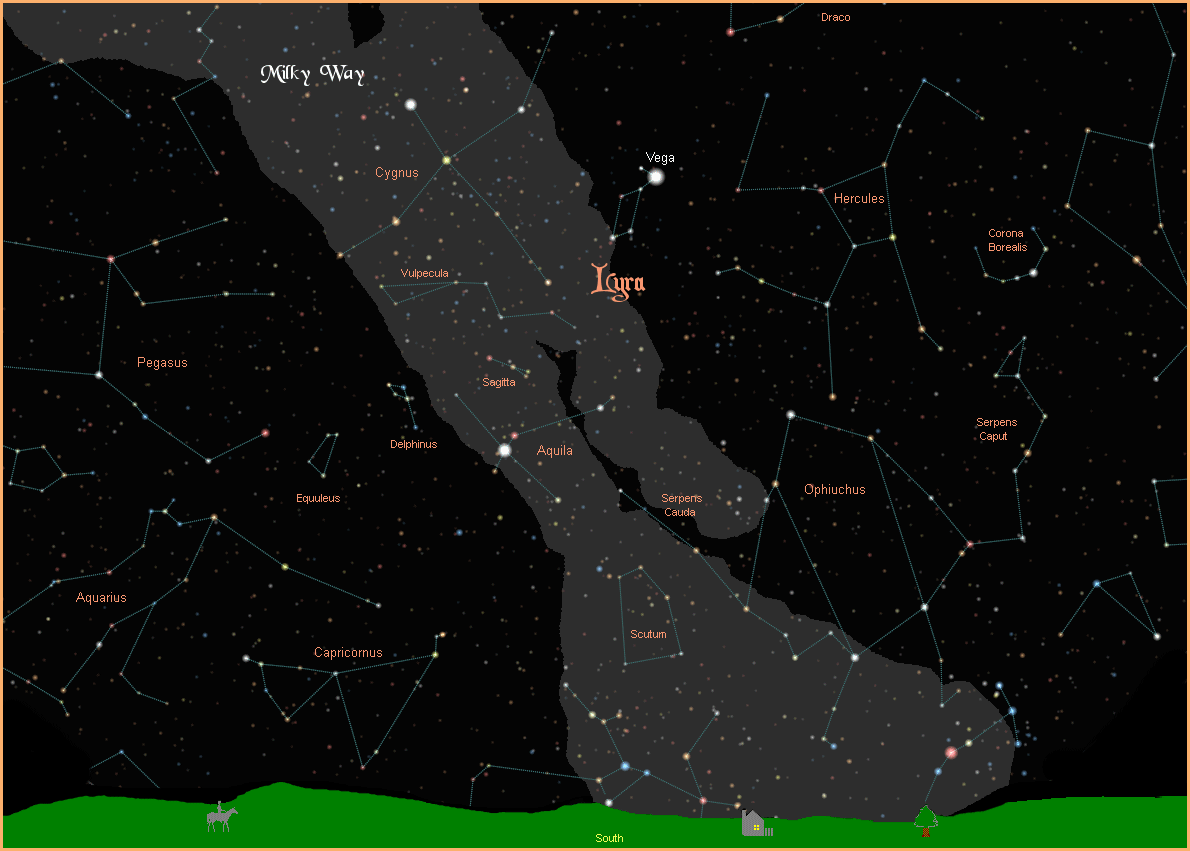
Alpha Lyrae is the famous Vega, Arabic for vulture, the bird that carried the lyre of Orpheus into the heavens after his death. At a magnitude of 0.03 Vega is the fifth brightest star in the sky, far outshining all other stars around it. At a distance of only 25.1 light years it is also one of the closest stars to Earth, making it the subject of much study. It is an A1V white main sequence star, twice the size of our Sun and half again as hot, with a surface temperature of 9,600 degrees K.
Vega's brightness and proximity have made it a staple in the science fiction genre. It has appeared in numerous novels, including the works of Isaac Asimov and Robert Heinlein, and the star appears in several episodes of Star Trek as well. In Carl Sagan's book and movie Contact advanced aliens used Vega to relay a message to Earth.
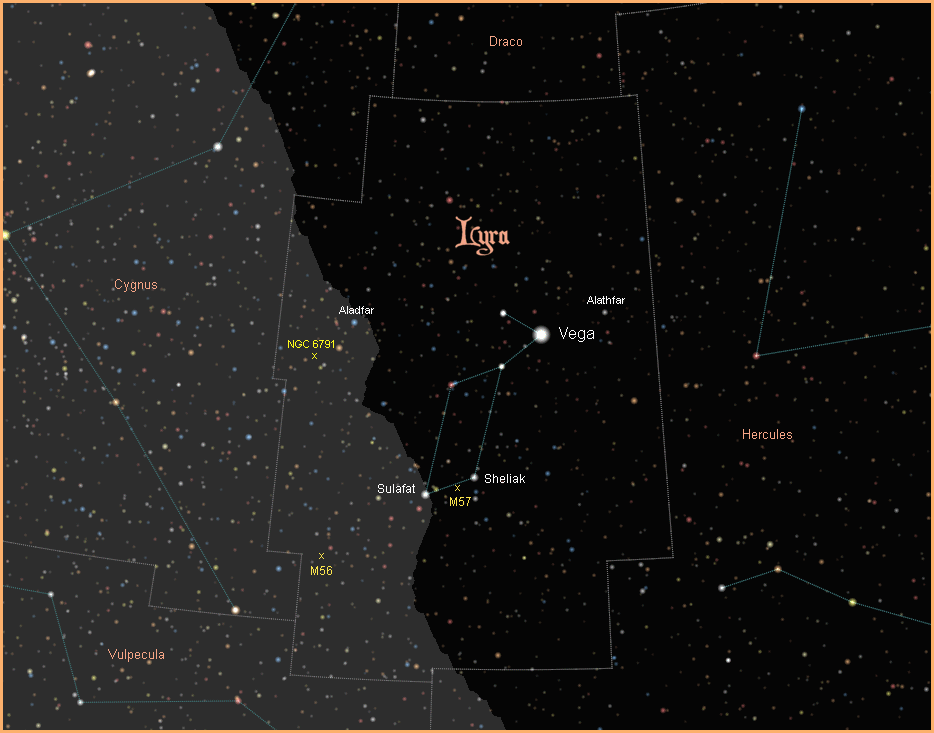
Beta Lyrae is named Sheliak, Arabic for harp. It is a binary system, composed of two very hot stars, very far away, at a distance of about 960 light years. The larger star is a B7 blue/white giant with a surface temperature of 14,500 degrees K, more than twice as hot as our Sun. Its smaller companion is a B0 blue dwarf with a much hotter surface temperature of 30,400 degrees K.
The two stars orbit each other so closely they cannot be separated visually. The much higher mass and therefore gravity of the super dense dwarf is slowly but surely consuming the larger giant. The stars also regularly eclipse each other every 6.5 days, causing their combined magnitude to change from 3.4 to 4.6 and back again, easily noticed with the naked eye, and ranking Sheliak as third brightest star in the constellation.
Gamma Lyrae has the name Sulafat, Arabic for tortoise, from which the first lyre was formed. Like Sheliak, it is very far away at a distance of 635 light years. Even at that great distance it shines with a magnitude of 3.26, making it the second brightest star in Lyra. Sulafat is a A1III blue/white giant, 15 times the radius of our Sun, and over 2,000 times brighter.
Eta Lyrae is Aladfar, from the Arabic "Al Athfar", the talons. It is a hot, B2V blue/white main sequence star, the most distant of the named stars at 1,359 light years and a magnitude of 4.43.
Mu Lyrae is Alathfar, the vulture's other set of talons. It is a A2V white main sequence star, at a distance of 440 light years and a magnitude of 5.11.
Launched in March, 2009, the most light sensitive telescope ever built, NASA's state of the art planet hunter, the Kepler Space Telescope spent four years looking for Earth-like exoplanets, and it found plenty. The telescope was put into orbit around the Sun, millions of miles away from Earth, to avoid any contamination of its sensitive equipment. Kepler remained focused on one spot, simultaneously and continuously monitoring the light from 145,000 stars, to detect the minute changes caused by any planets that might be transiting (crossing in front of) them. An area on the edge of the Milky Way, close to the galactic plane, encompassing parts of Cygnus, Lyra, and Draco was targeted.
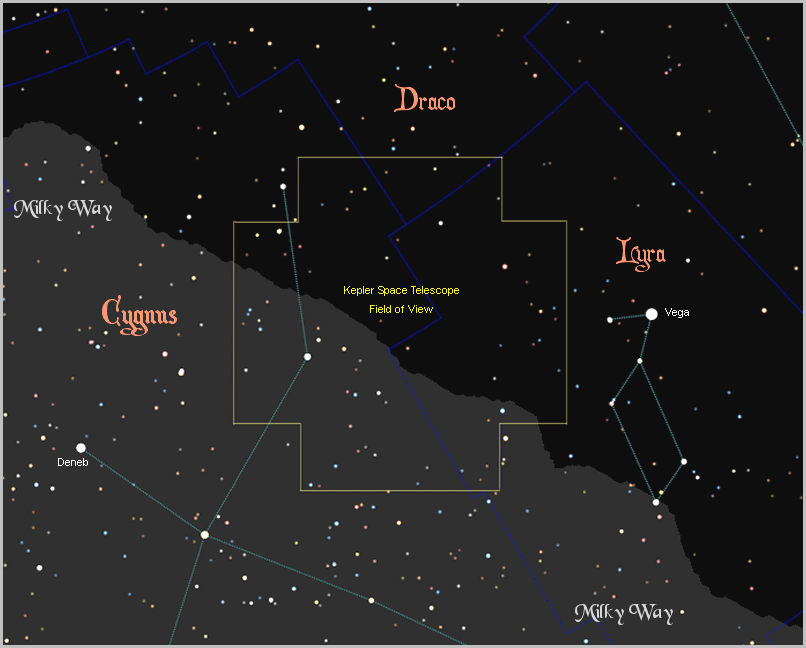
Four years later Kepler had 977 confirmed planet discoveries under its belt, and more than 3,000 potential planet candidates awaiting confirmation. The Kepler mission took planet hunting to a whole new level. It proved what common sense had always predicted, that planets are as ubiquitous as the stars themselves, and perhaps even more so. Kepler found planets of every type around stars of every type. It showed us that we live in a Universe filled with planets. It confirmed the premise that planets are a natural byproduct of star formation, and they are all around us. Statistical analysis of Kepler data predicts the presence of 40 billion Earth-like planets in our galaxy alone, the closest of these within twelve light years of us. Of course what this says about the possible existence of life beyond Earth is self evident. For more information on the Kepler mission, go to http://kepler.nasa.gov/.
Since almost half of Kepler's field of view was in Lyra, there are now hundreds of stars with confirmed planets in this constellation, far too many to list here. Unfortunately, out of all those hundreds of stars there isn't even one that is visible to the naked eye. They are all too far away. Despite their distance however, there are a couple worth mentioning. A star named Kepler 102 has no less than five Earth-like terrestrial planets around it. Unfortunately they all appear to orbit dangerously close to the star. The system is 389 light years away.
Another system around the star Kepler 62 also has five Earth-like planets, and two of these appear to orbit in the habitable zone, where liquid water can exist. The bad news is the system is very far away, at a distance of 1,200 light years. The NASA artwork below suggests that if we ever find a way to travel such a distance, it might prove to be a very interesting place. For more information on these and other extrasolar planets, visit NASA's New Worlds Atlas, and The Open Exoplanets Catalogue.
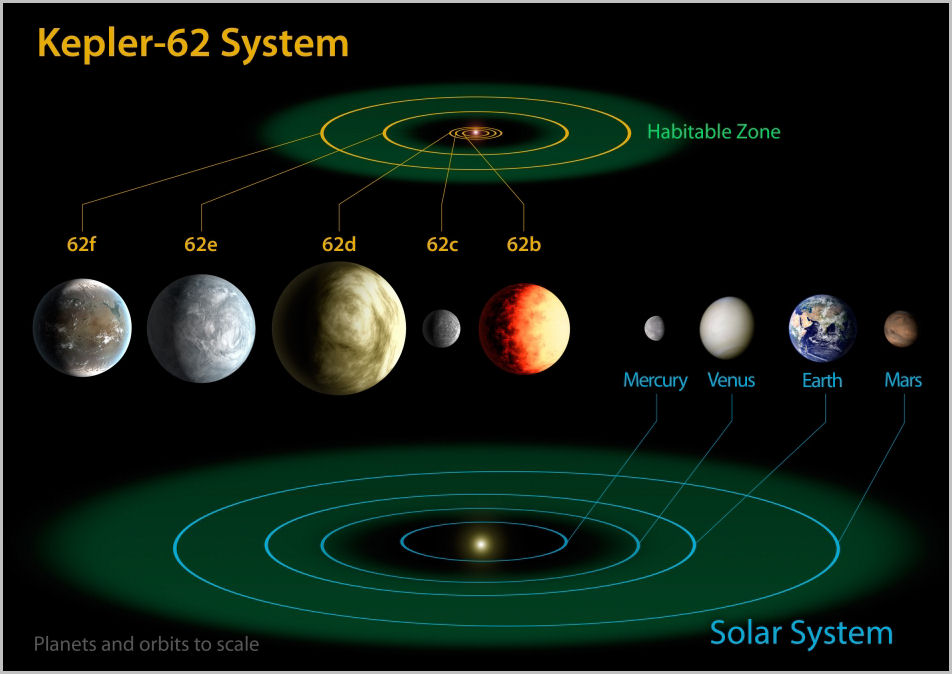
Lyra contains two Messier objects. The first is M56, a globular star cluster, 32,900 light years away, and 85 light years in diameter. At magnitude 8.3 it is a good target for a small telescope.
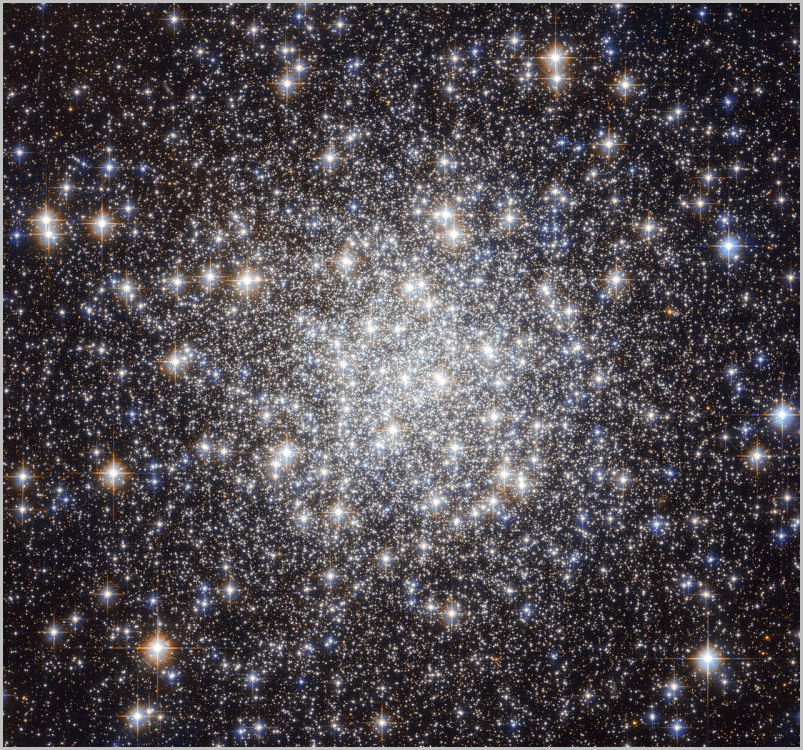
Lyra also contains probably the most accessible and well known planetary nebula in the sky, M57, also known as the Ring Nebula. It is usually one of the first deep sky objects explored by amateur telescopes, as it is easy to find, halfway between the stars Sheliak and Sulafat. M57 has a magnitude of 8.8, and is 2,000 light years from Earth. Below you can see the true splendor of the nebula through the eyes of the Hubble Space Telescope.
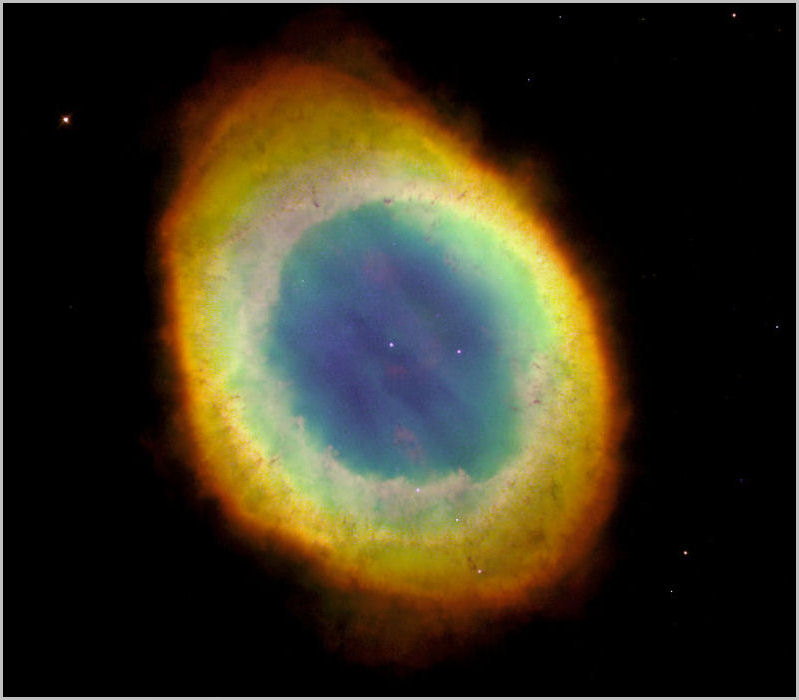
About 13,300 light years away is the densely packed open star cluster NGC 6791, with a magnitude of 9.5. The composite below shows a Digital Sky Survey image of the cluster on the left, and Hubble Space Telescope images on the right. The top wide field Hubble image shows two far away galaxies in the upper left, and the bottom close-up Hubble image reveals a surprising number of white dwarfs (circled).
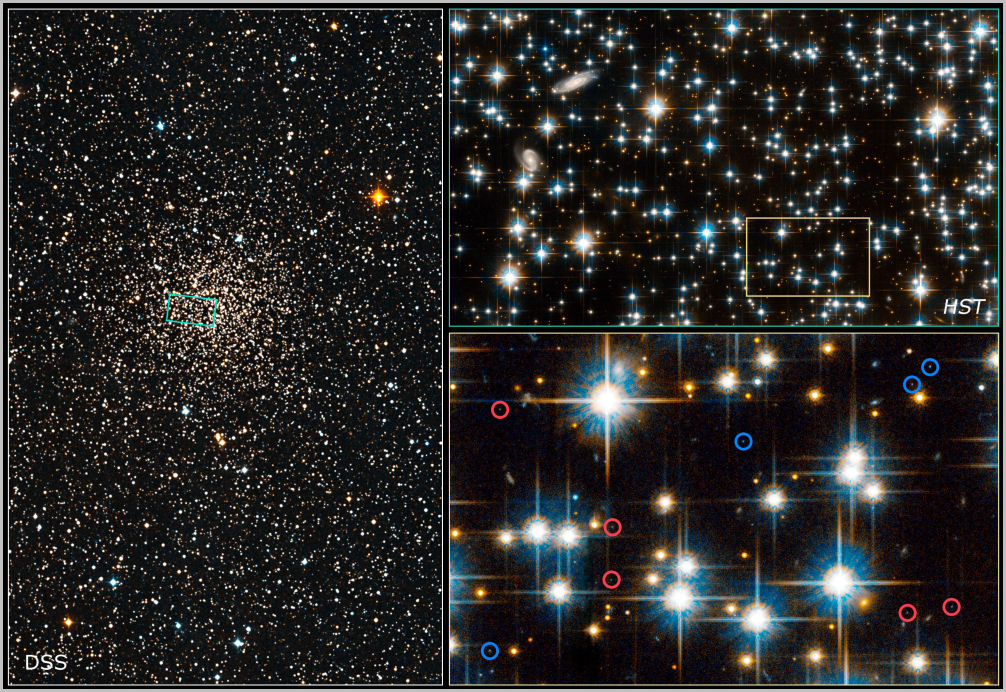
|
|
|
|
|
|